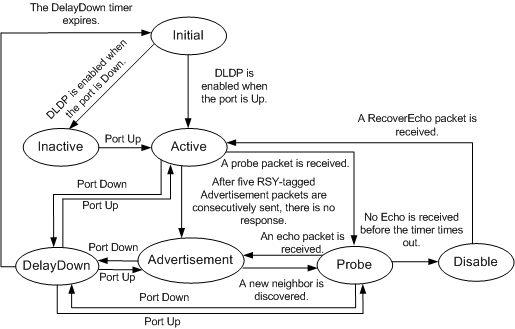DLDP States
The Device Link Detection Protocol (DLDP) allows a device to identify the remote device and check connectivity of the unidirectional link by exchanging DLDP Data Units (DLDPDUs) with the remote device. DLDP defines the following states: Initial, Inactive, Active, Advertisement, Probe, Disable, and DelayDown.

State |
Description |
|---|---|
Initial |
DLDP is disabled. |
Inactive |
DLDP is enabled but the link is Down. |
Active |
DLDP is enabled and the link is Up, or neighbor entries are cleared. |
Advertisement |
All neighbors are bidirectionally reachable or have been in Active state for more than 5 seconds. This is a stable state when no unidirectional link has been detected. |
Probe |
Probe packets are sent to detect whether the link is unidirectional. When an interface enters this state, DLDP starts the probe timer and starts an echo timer for each neighbor to be detected. |
Disable |
DLDP in enhanced mode detects a unidirectional link and disables the interface that fails to send optical signals. |
DelayDown |
When an interface in Active, Advertisement, or Probe state receives a Port-Down event, the interface enters the DelayDown state but does not immediately delete neighbor entries and transitions to the Inactive state. In DelayDown state, the system reserves DLDP neighbor information and only responds to Port-Up events. |